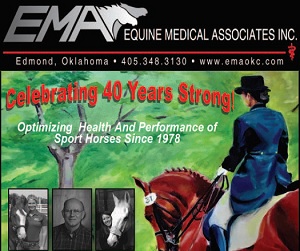Written By Dr. Kris Hiney
Equine Extension Specialist
Oklahoma State University
You see your pride and joy grasp a board rail with his upper incisors, arch his neck and inhale loudly. Your heart drops. You now have a cribber. Will he teach it to others, destroy your property or immediately decline in value?
While cribbing doesn’t top the list on desired equine characteristics, it may not be as bad as you think. Understanding why your horse might be cribbing may make more of a difference to his overall well-being than just preventing the behavior.
First of all, to understand why horses crib, it is helpful to explain exactly what this unusual behavior is. In older terminology, and even still in some textbooks, cribbing was described as a stable vice, which essentially put the blame on the horse. Today, cribbing is understood to be a stereotypy (pronounced as STERR-ee-oh-ty-pee), which is essentially a behavior that is repeated over and over with no apparent function, in response to some sort of environmental stressor.
Stereotypies are seen in a wide variety of animals, even people, although never reported in the wild. If you have ever seen large cats pace their enclosure at a zoo or polar bears repeating a swimming pattern, that is a stereotypy. Cribbing behavior in horses is often used as a hallmark stereotypy in teaching psychology students. This collection of behaviors indicates that at some point in time the animal’s environment was suboptimal and created sufficient stress or frustration to elicit the behavior.
Why do they crib?
Cribbing in horses should really be thought of as a coping mechanism. It is believed that the action of cribbing causes a release of one of the feel-good hormones—dopamine. It has also been shown to decrease cortisol levels and heart rates in cribbing horses. Recent research indicates that it may reset the brain to experience greater pleasure with some actions in contrast to non-cribbers. In fact, some horses may relish that feeling enough to choose cribbing over eating. The very fact that cribbing creates positive feedback to the horse makes it an engrained habit, which is hard to extinguish. Even if the horse’s environment has been changed to be much less stressful, the cribbing behaviors may remain.
While the exact why is not known, we do know there are specific genetic and environmental risk factors. In particular, isolation (such as a young horse weaned in a solitary stall), low-forage intake combined with high-grain diets, and stress can all contribute to the development of stereotypies.
Low-forage diets, in particular, can be problematic as: 1.) they greatly increase the time between eating and, therefore, can increase boredom or 2.) they can create an acidic environment in the stomach, which can be quite painful. In young horses, some researchers have found an association between cribbing behavior and the presence of ulcers, but others have failed to link the two together.
The genetic story is also a bit unclear. There is no genetic test to say, yes, your horse will be a cribber or he or she will pass it on to offspring. There is a greater chance for Thoroughbreds to become cribbers than other breeds. However, many of these horses’ lifestyles and environments as racehorses (stalled, high-grain diets, stress) also contribute to cribbing. The genetics may contribute to a horse’s risk of becoming a cribber but only under the right (or wrong) environmental conditions. Other horses with low genetic risk may be able to tolerate much more stressful environments without ever developing a stereotypy. One can see how it is difficult to piece out the exact cause.
Many owners worry that a horse will damage itself physically by cribbing, and it is possible. The dedicated or hard-core cribber may actually damage its incisors from the repeated wear and tear of grasping a solid object. There is also a specific type of colic, epiploic foramen entrapment, that is 10 times more likely to occur in horses that crib. If a horse that cribs has a history of colic, it may be more important to prevent the behavior. But remember, pain or gastrointestinal discomfort may have caused the cribbing in the first place.
Can you prevent or eliminate cribbing?
Well, if you see a young horse beginning to crib, the time to intervene is now. Certainly, all attempts should be made to improve the horse’s environment. More social time with fellow horses, turnout time on pasture and maximizing forage intake are all key. Some horses that crib in stalls may drastically reduce or even eliminate the behavior if turned out on pasture. However, expect the behavior to immediately return if placed back into the same conditions that originally stimulated the behavior. If horses must be stalled, use slow feeding hay nets, which will increase the total amount of feeding time. Adding some alfalfa to the diet may also help as it is thought to provide some buffering capacity to the stomach.
If we remember, fundamentally, that cribbing is a coping mechanism, it may be unfair to prevent the horse from performing the behavior without trying to address what caused it in the first place. However, if the horse may be removed from a facility unless preventative measures are taken, an owner may need to do so.
The use of shock collars should be discouraged as the intensity has to be continually turned up to prevent the behavior. There are other restrictive devices, such as cribbing collars or straps, that may be used if needed. As mentioned before, in horses that may choose to crib rather than eat, the use of a collar may help them maintain weight.
The use of cribbing straps or collars is not without risk however. If overly tightened, they can cause lesions. On rare occasions, horses can become hung up on the collar. Regular inspection of the horse is key. Other strategies, such as putting an electric wire on wooden fences, may prevent the behavior. However, just like some horses can learn to crib while wearing a collar, a determined horse can learn to twist its head and latch onto a post.
There is also no documented evidence that one horse can teach another to crib despite the long-held beliefs of many horsemen. If there are multiple horses at a facility that crib, a careful look at the environmental conditions of those horses is warranted.
So is it the end of the world?
It doesn’t have to be. Most likely, he is just trying to get by in the world, just like us. And remember, if your horse already had the habit, the persistence of cribbing does not mean his welfare is compromised. Continue to make his life as stress-free as possible, and don’t sweat the cribbing things.

